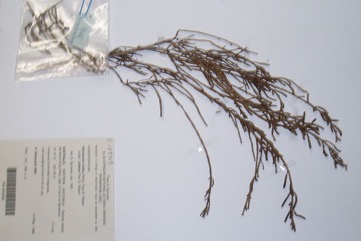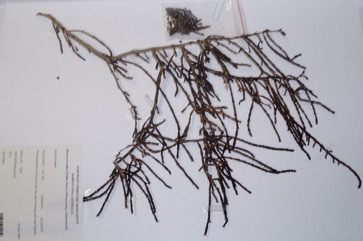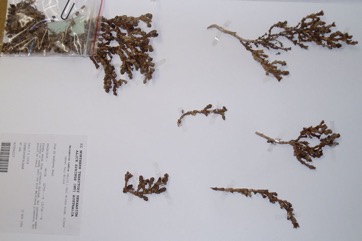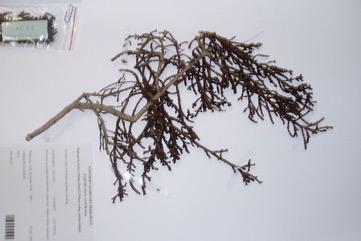Brown-headed glasswort, Marsh Samphire

A tropical plant. It can grow in salty soil. It grows in seasonally waterlogged places. It grows on tidal mud flats. It grows on tropical coasts. It can grow in dry areas. It grows in areas with a rainfall between 100-600 mm per year. It can grow on the land ward side of mangroves that are occasionally flooded. It can grow in arid places.
Also known as:
Bholado, Ciri-ciri, Jadu palang, Koyaloo, Koyalu, Koyya pippali, Koyya-pippili, Machola, Machul, Machur, Muchul, Oomarie keeray, Queiloo, Pavala poondoo, Samphire, Subhar, Suvar, Umari, Umari keerai
Synonyms
- Arthrocnemum brachiata Miq.
- Arthrocnemum ciliolatum Bunge
- Arthrocnemum indicum (Willd.) Moq.
- Arthrocnemum leiostachya (Benth.) Paulsen
- Salicornia brachiata Miq..
- Salicornia indica Willd.
- and others
Edible Portion
- Branches, Leaves, Vegetable
Where does Brown-headed glasswort grow?
Found in: Africa, Asia, Australia, East Africa, India, Indochina, Kenya, Madagascar, Malaysia, Mozambique, Pakistan, SE Asia, Somalia, Sri Lanka, Tanzania, Vietnam, Zambia
Notes: There are 25 Halosarcia species. Most are in Australia. Also put in the family Chenopodiaceae.
Status: It is a famine food. It is only a minor food.
Growing Brown-headed glasswort, Marsh Samphire
Cultivation: Plants can be grown from seed or cuttings.
Edible Uses: The outer corky layer is removed then the branches are eaten as a cooked vegetable. The plant is sour and eaten raw or cooked. They are also pickled. The young branches in vinegar are used as a vegetable. The leaves and shoots are eaten as greens as a pot herb. They are also pickled. The ash can be used as a salt substitute.
Nutrition Info
per 100g edible portion| Edible Part | Energy (kcal) | Protein (g) | Iron (mg) | Vitamin A (ug) | Vitamin c (mg) | Zinc (mg) | % Water |
|---|---|---|---|---|---|---|---|
| - | - | - | - | - | - |
Brown-headed glasswort, Marsh Samphire Photos




References
Ambasta S.P. (Ed.), 2000, The Useful Plants of India. CSIR India. p 56 (As Arthrocnemum indicum and Salicornia brachiata)
Bircher, A. G. & Bircher, W. H., 2000, Encyclopedia of Fruit Trees and Edible Flowering Plants in Egypt and the Subtropics. AUC Press. p 42 (As Arthrocnemum indicum)
Cooper W & Cooper W T, 1994, Fruits of the Rain Forest. RD Press p 156
Edible and Useful Native Plants (off internet)
Elliot, W.R., & Jones, D.L., 1990, Encyclopedia of Australian Plants suitable for cultivation. Vol 5. Lothian. p 248
Flora of Australia, Volume 4, Phytolaccaceae to Chenopodiaceae, Australian Government Publishing Service, Canberra (1984) p 298
Flora of Pakistan. www.eFlora.org (As Arthrocnemum indicum)
Grubben, G. J. H. and Denton, O. A. (eds), 2004, Plant Resources of Tropical Africa 2. Vegetables. PROTA, Wageningen, Netherlands. p 310
Hedrick, U.P., 1919, (Ed.), Sturtevant's edible plants of the world. p 589 (As Salicornia brachiata)
Joshi, A., et al, 2018, Halophytes of Thar Desert: Potential source of nutrition and feedstuff. International Journal of Bioassays 8.1 (2018) pp. 5674-5683 (As Arthrocnemum indicum)
Kenneally, K.E., Edinger, D. C., and Willing T., 1996, Broome and Beyond, Plants and People of the Dampier Peninsula, Kimberley, Western Australia. Department of Conservation and Land Management. p 84
Lazarides, M. & Hince, B., 1993, Handbook of Economic Plants of Australia, CSIRO. p 128
Low, T., 1992, Bush Tucker. Australia’s Wild Food Harvest. Angus & Robertson. p 137
Martin, F.W. & Ruberte, R.M., 1979, Edible Leaves of the Tropics. Antillian College Press, Mayaguez, Puerto Rico. p 182 (As Arthrocnemum indicum)
Melzer, R. & Plumb, J., 2011, Plants of Capricornia. Belgamba, Rockhampton. p 517
Paczkowska, G. & Chapman, A.R., 2000, The Western Australian Flora. A Descriptive Catalogue. Western Australian Herbarium. p 204
Pham-Hoang Ho, 1999, An Illustrated Flora of Vietnam. Nha Xuat Ban Tre. p 725 (As Arthrocnemum indicum)
Royal Botanic Gardens, Kew (1999). Survey of Economic Plants for Arid and Semi-Arid Lands (SEPASAL) database. Published on the Internet; http://www.rbgkew.org.uk/ceb/sepasal/internet [Accessed 7th April 2011] (As Arthrocnemum indicum)
Shah, G.L., 1984, Some economically important plant of Salsette Island near Bombay. J. Econ. Tax. Bot. Vol. 5 No. 4 pp 753-765 (As Arthrocnemum indicum)
SHORTT, (As Salicornia brachiata and Salicornia indica)
Singh, H.B., Arora R.K.,1978, Wild edible Plants of India. Indian Council of Agricultural Research, New Delhi. p 39 (As Arthrocnemum indicum and Salicornia brachiata)
Thiselton-Dywer, W.T., (Ed.), 1913, Flora of Tropical Africa. Vol VI-section 1. Reeve, p 86 (As Arthrocnemum indicum)
WATT (As Arthrocnemum indicum and Salicornia brachiata)
Wheeler, J.R.(ed.), 1992, Flora of the Kimberley Region. CALM, Western Australian Herbarium, p 101
Williams, K.A.W., 1999, Native Plants of Queensland Volume 4. Keith A.W. Williams North Ipswich, Australia. p 218